Shrubs of the Adirondack Park
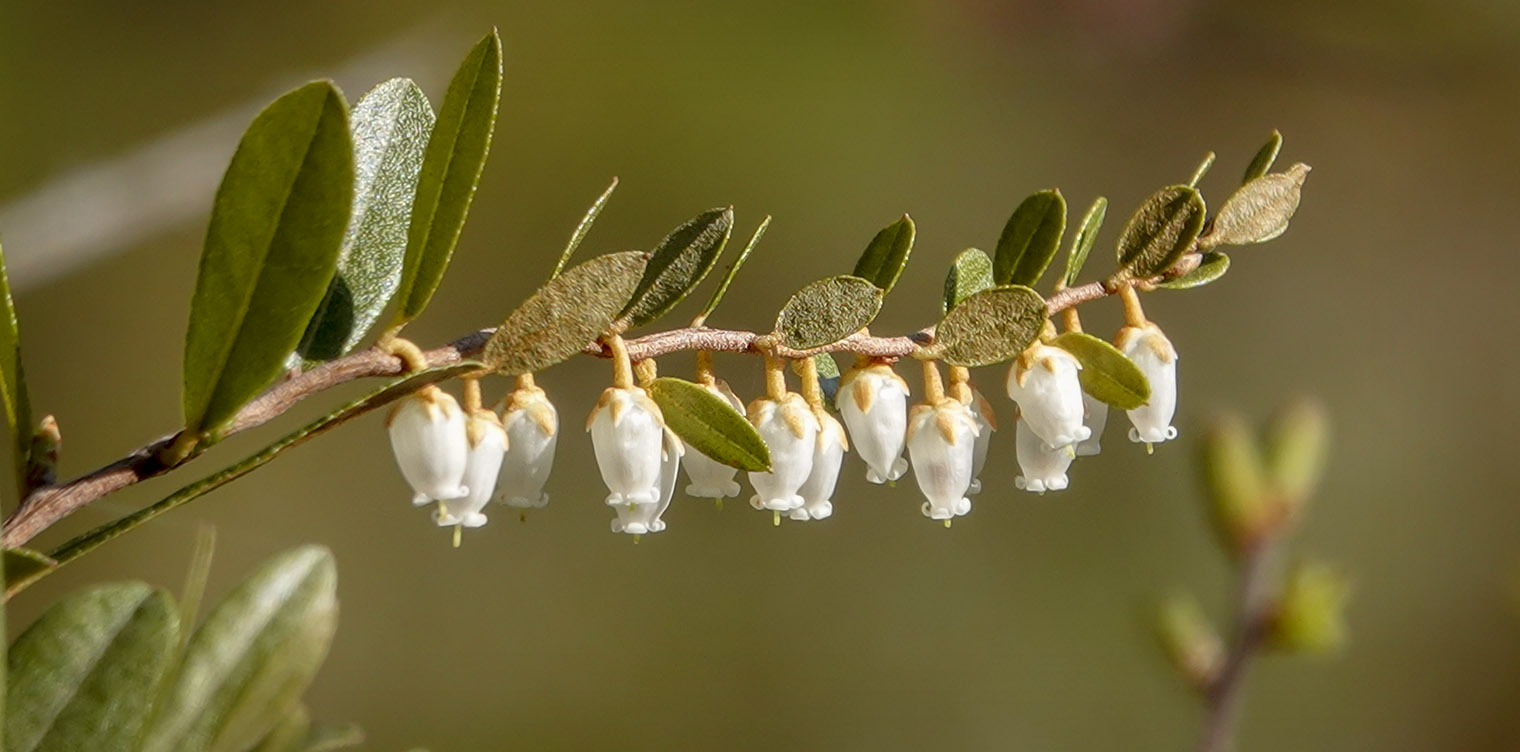
A shrub is a perennial, multi-stemmed woody plant. It is distinguished from a tree by its multiple stems and shorter height, usually under 16 feet. Under certain environmental, condition, shrubs may be taller than 16 feet or single-stemmed.
Like trees, shrubs can be deciduous (like Steeplebush, Hobblebush, and Northern Wild Raisin) or evergreen (like Labrador Tea and Leatherleaf). The foliage of some deciduous shrubs turns brilliant purple or yellow before being shed prior to the winter season. Many shrubs, both evergreen and deciduous, have showy flowers in spring.
Role in Ecological Communities
Shrubs play a vital role in many of the Adirondack's ecological communities.
- In mature forests, including many of the Northern Hardwood Forests and Mixed Wood Forests that have been recovering from forest disturbances over a century ago, shrubs form a layer below the canopy (formed by the crowns of the tallest trees) and the understory (which consists of smaller tree species and saplings). The shrub layer is below these two layers and above the herb layer of ferns and wildflowers which grow on the forest floor below.
- In early successional forests and old fields, shrubs play a more dominant role. In abandoned fields, shrubs usually began infiltrating the site within several years after abandonment, shading out the herbs and grasses. During this stage, shrubs represent less than 50% cover. Successional shrublands, with at least 50% cover of shrubs, occur on sites that have been cleared (for farming or logging) or otherwise disturbed for a longer period of time.
- Shrubs also play a dominant role in very acidic sites, such as bogs, where most trees are unable to grow and therefore do not provide a canopy.
Shrubs of Hardwood and Mixed Wood Forests
Shrubs of Hardwood and Mixed Wood Forests in the Adirondack Park
- American Fly Honeysuckle (Lonicera canadensis)
- Canada Yew (Taxus canadensis)
- Hobblebush (Viburnum lantanoides)
- Maple-leaf Viburnum (Viburnum acerifolium)
- Northern Wild Raisin (Viburnum nudum var. cassinoides)
- Red Elderberry (Sambucus racemosa)
- Witch Hazel (Hamamelis virginiana)
Shrubs are an important component of northern hardwood and mixed wood forests in the Adirondack Park, growing in the shade of both canopy trees and smaller trees and saplings in the understory. The most frequently-encountered shrub in these habitats is the familiar Hobblebush. One of our most common Adirondack shrubs, Hobblebush is a deciduous shrub which abounds in rich, moist woods throughout the Adirondack Mountains. This shrub is relatively flexible in terms of its soil and site requirements. It is very shade tolerant. It can grow on well or imperfectly drained soils, under either northern hardwoods or spruce-fir. Hobblebush produces flat-topped clusters of fragrant white flowers in the spring, followed in late August or September by red berries gradually changing to dark blue/purple.
Other shrubs found in mixed wood forests include American Fly Honeysuckle (Lonicera canadensis). As the name implies, this shrub is a member of the Honeysuckle family. A native deciduous shrub, the American Fly Honeysuckle can be found in most counties in the eastern two-thirds of New York State, including all counties in the Adirondack Park. American Fly Honeysuckle grows in well-drained soils in established hardwood stands. This shade-tolerant shrub usually grows as isolated individuals, rather than in vast colonies or stands. American Fly Honeysuckle flowers in May in our region, producing funnel-shaped yellow or greenish-yellow flowers. The tubular flowers attract Ruby-throated Hummingbirds, as well long-tongued insects. The deep red fruits mature in July.
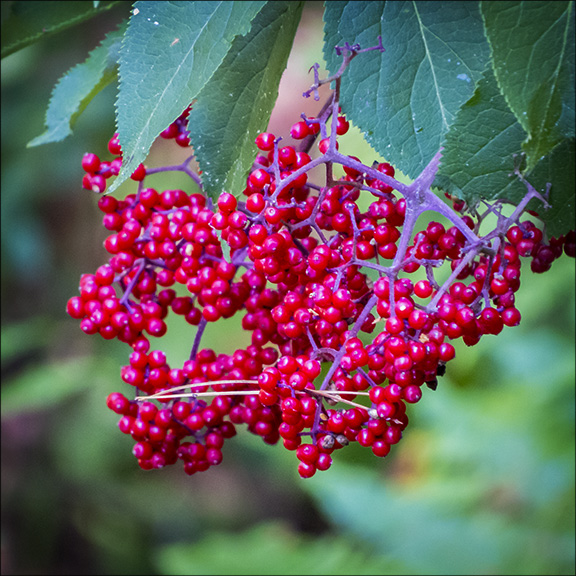
Red Elderberry (Sambucus racemosa), another member of the Honeysuckle family, is a large native deciduous shrub or small tree. It produces clusters of tiny white or cream flowers in early spring, followed by bright red berries. The berries can be seen in mid-July through early August in the Adirondack Mountains. This shrub grows in well-drained sites in both northern hardwood and mixed wood forests. Its presence has been documented in all counties within the Adirondack Park.
Red Elderberry provides fair to good food and cover for birds and some insects. Hummingbirds and butterflies collect nectar from the flowers. Although these shrubs are usually not abundant enough at any single site for the fruits to provide significant amounts of wildlife food, many birds – especially Red-eyed Vireos, Ruffed Grouse, Song Sparrows, woodland thrushes, Gray Catbirds, and Brown Thrashers – relish them. The shrub is also moderately useful to mammals, providing habitat, cover, and food. The Eastern Chipmunk, American Black Bear, Raccoon, and Red Squirrel reportedly eat the fruit. Porcupines, mice, and Snowshoe Hares consume Red Elderberry buds and bark in winter.
Shrubs of Adirondack Wetlands
Shrubs of Adirondack Wetlands
- Bog Laurel (Kalmia polifolia)
- Bog Rosemary (Andromeda polifolia)
- Hobblebush (Viburnum lantanoides)
- Labrador Tea (Rhododendron groenlandicum)
- Leatherleaf (Chamaedaphne calyculata)
- Mountain Holly (Ilex mucronata)
- Northern Wild Raisin (Viburnum nudum)
- Pussy Willow (Salix discolor)
- Redosier Dogwood (Cornus sericea)
- Sheep Laurel (Kalmia angustifolia)
- Speckled Alder (Alnus rugosa)
- Steeplebush (Spiraea tomentosa)
- Sweetgale (Myrica gale)
- White Meadowsweet (Spiraea alba var latifolia)
- Winterberry Holly (Ilex verticillata)
Shrubs are a crucial part of wetland habitats, especially those wetlands (such as bogs) where only a few tree species grow, and many of them remain stunted. Many of the Adirondack's wetland-dwelling shrubs are evergreen members of the Heath family.
Leatherleaf (Chamaedaphne calyculata) is an example. It is a member of the Heath family which produces small, bell-shaped white flowers in spring. The nodding white flowers are about 1/4 inch long and hang from the upper leaf axils in one-sided, spike-like clusters. The flowers sometimes have a pinkish tint. The name derives from the leathery appearance of the leaves, which are alternate and elongated oval or elliptical in shape. The upper surfaces of the leaf are dark green with a smooth sheen; the undersides have small brown scales. Older leaves are brownish bronze above and yellowish beneath. The foliage often turns red-brown in winter. Leatherleaf is mostly confined to acidic peatlands and can be found in bogs, the edges of ponds, and acidic peaty open sites.
Bog Rosemary (Andromeda polifolia), another shrub characteristic of Adirondack peatlands, is also a member of the Heath family. It starts blooming in late May in our region, producing small terminal clusters of bell-shaped nodding flowers. Each flower is about a quarter of an inch long. The flowers are usually pale pink, but can also be white. The dark green evergreen leaves are two inches long and about a quarter of an inch wide. The leaf margins are smooth. The leaves are alternate; that is, the leaves merge from the stem one at a time. The leaves roll inwards. The underside of the leaves is whitened by tiny hairs. The fruit is a dry, rounded capsule, appearing in July. Like Leatherleaf, Bog Rosemary is mostly confined to acidic bogs.
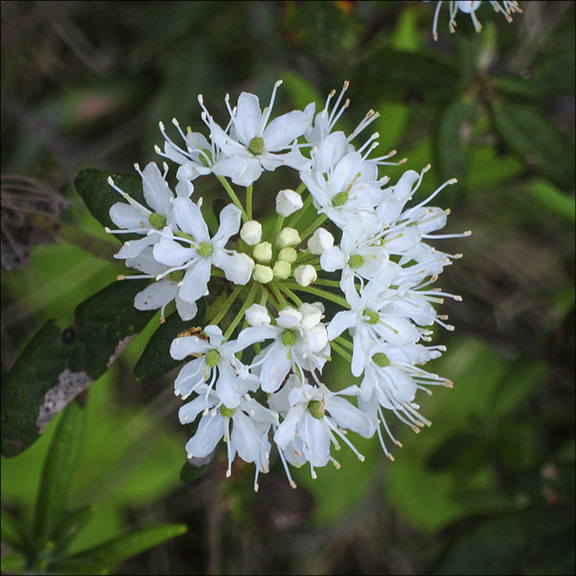
Labrador Tea (Rhododendron groenlandicum), another member of the Heath family, is a low evergreen shrub that produces rounded, terminal clusters of tiny white flowers in late May or early June. The tiny white flowers are very fragrant and sticky. This northern shrub, typical of acidic, boggy areas, can easily be recognized by the woolly brown undersurfaces of its leaves. It grows up to three feet tall, with smooth bark which is coppery-orange to reddish brown. The thick, glossy, narrowly elliptic leaves are aromatic. Their smooth edges turn downward, creating a raised rim around the lower surface, which is covered by a dense mat of tangled woolly hairs. These hairs are white on young leaves and rusty on mature leaves. This shrub is found in bogs, wet peaty sub-alpine forest openings, and rocky high elevation sites.
Two laurels, also members of the Heath family, are found in Adirondack wetlands: Bog Laurel (Kalmia polifolia) and Sheep Laurel (Kalmia angustifolia). Both are evergreen; both produce pink flowers growing in clusters.
- Bog Laurel grows in acidic bogs. Its leaves are leathery and have smooth edges that turn downward. This shrub produces clusters of small, cup-shaped pink flowers in mid- to late-spring.
- Sheep Laurel, which bears a cluster of deep pink flowers from late spring to midsummer, has less restrictive habitat requirements. It can be found in wet acidic peatlands, sub-alpine forests, dry sandy forests, and forest edges. Its flowers are very similar to those of Bog Laurel. However the flowers of Sheep Laurel appear a few inches from the top of the stem, with newer leaves above the cluster of flowers. The flowers of Bog Laurel, by contrast, form clusters at the end of the stem.
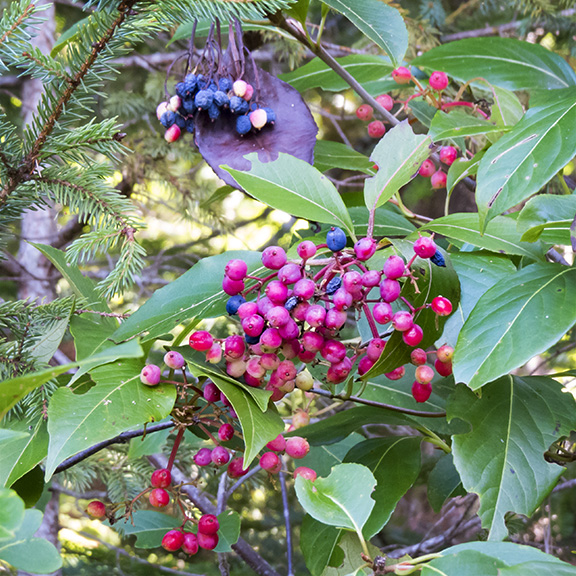
Another shrub commonly found in Adirondack wetlands – this time a member of the Honeysuckle family – is Northern Wild Raisin (Viburnum nudumvar cassinoides). This deciduous shrub, also known as Withe Rod, produces clusters of small white flowers in late June and colorful, pinkish berry-like fruit which matures to near-black in fall. Northern Wild Raisin is found in most counties within the Adirondack Park. It usually occurs in poorly-drained soils, such as swamps, boggy areas, or on the edges of marshes and pond. However, it can occasionally be found in non-wetlands on fairly well-drained soil.
Another native deciduous shrub that flourishes in Adirondack wetlands is Steeplebush (Spiraea tomentosa), a member of the Rose family. This plant forms a mound-shaped thicket of slender, unbranched stems, three to four feet tall. Steeplebush produces attractive spike-like clusters of deep pink to rose-purple flowers in late July and August. The flowers have five petals; they are about 1/4 inch wide and form a three- to four-inch cluster. Butterflies and other nectar-feeding insects find the flowers highly attractive. Steeplebush grows in streamside meadows, wet thickets, ditches, peatlands, swamps, and marshes.
Shrubs of Old Fields and Early Successional Forests
Shrubs of Old Fields and Early Successional Forests
- Allegheny Blackberry (Rubus allegheniensis)
- American Red Raspberry (Rubus idaeus)
- Carolina Rose (Rosa carolina)
- Chokecherry (Prunus virginiana)
- Gray Dogwood (Cornus racemosa)
- Hobblebush (Viburnum lantanoides)
- Nanny-berry (Viburnum lentago),
- Silky dogwood (Cornus amomum)
- Southern Arrowwood (Viburnum dentatum var.lucidum)
- Staghorn Sumac (Rhus typhina)
- White Meadowsweet (Spiraea alba var latifolia)
Shrubs are a dominant component of both abandoned agricultural land (old fields) and early successional forests which emerge later in old field succession or after logging operations, fire, or weather disturbances. The shrubs which infiltrate these sites vary, depending on the elevation of the site, drainage, and soil, among other factors. The shrubs in these ecological communities provide food and cover for a wide variety of wildlife. In many cases, the dominant role of shrubs in these ecological communities fades as the site is taken over by trees; and the wildlife associated with such habitats declines as well.
Allegheny Blackberry (Rubus allegheniensis) is one of the most abundant shrubs to emerge after logging operations. This shade-intolerant, deciduous shrub prefers well-drained soils and is a common pioneer on old fields, following logging roads, logged over-areas, and the edges of woods. On the Forest Ecosystem Research and Demonstration Area (FERDA) plots at the Paul Smiths VIC, Allegheny Blackberry had colonized all five of the treatment plots in the decade following logging and was especially abundant on the clear cut plot. This shrub flowers in early summer and produces its black fruit in late August and September. This plant ranks at the very top of summer foods for wildlife. Its fruit is an important component of the summer diet of many songbirds and game-birds, as well as raccoons, chipmunks, squirrels, and other rodents. The plant also attracts a large number of native bees.
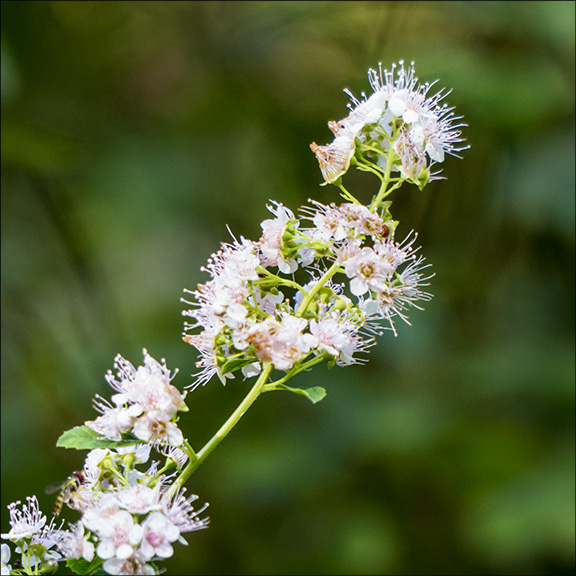
White Meadowsweet (Spiraea alba var latifolia), a member of the Rose family, is a native Adirondack shrub that produces white or pale-pink flower clusters in summer and usually blooms in the Adirondack Park from July to mid-August. Although it it not ranked as an important wildlife food, Meadowsweet twigs are eaten by Snowshoe Hares and White-tailed Deer. Cottontail Rabbits occasionally browse the lower leaves and twigs. Ruffed Grouse are said to consume the buds. Several bird species build their nests in Meadowsweet; the flowers of this shrub provide nectar to a number of butterfly species, including Atlantis Fritillary and White Admiral.
White Meadowsweet grows in a variety of habitats. It is particularly abundant in old fields and swamps, especially on old burned-over out-wash plains. It also grows under power lines, in early successional forests and wet thickets, and along roadsides and trails. This plant is widely distributed in the eastern part of North America. It grows in nearly all counties in the eastern two-thirds of New York State and can be found in all counties within the Adirondack Park.
References
United States Department of Agriculture. Plants Database. Retrieved 4 February 2017.
Michael Kudish. Adirondack Upland Flora: An Ecological Perspective (Saranac, New York: The Chauncy Press, 1992).
Northern Forest Atlas. Images. Retrieved 13 November 2021.
Jerry Jenkins. Woody Plants of the Northern Forest. A Digital Atlas. (The Northern Forest Atlas Project, April 2020). Retrieved 13 November 2021.
John Kricher. A Field Guide to Eastern Forests. North America (Boston: Houghton Mifflin, 1998), pp. 154-219.
Peter J. Marchand. Nature Guide to the Northern Forest. Exploring the Ecology of the Forests of New York, New Hampshire, Vermont, and Maine (Appalachian Mountain Club, 2010), pp. 13-18, 56-93.
William K. Chapman and Alan E. Bessette. Trees and Shrubs of the Adirondacks: A Field Guide (Utica, New York: North Country Books, 1990).
Donald D. Cox. A Naturalist's Guide to Wetland Plants. An Ecology for Eastern North America (Syracuse University Press, 2002).
Alexander C. Martin, Herbert S. Zim, and Arnold L. Nelson. A Guide to Wildlife Food Habits (New York: Dover Publications, 1951).
Meiyin Wu and Dennis Kalma. Wetland Plants of the Adirondacks. Ferns, Woody Plants, and Graminoids (Trafford Publishing, 2011).
John Eastman. The Book of Swamp and Bog: Trees, Shrubs, and Wildflowers of Eastern Freshwater Wetlands (Stackpole Books, 1995).
John Eastman. The Book of Forest and Thicket: Trees, Shrubs, and Wildflowers of Eastern North America (Stackpole Books, 1992).
John Eastman. The Book of Field and Roadside: Open-Country Weeds, Trees, and Wildflowers of Eastern North America (Stackpole Books, 2003).
Janet Lyons and Sandra Jordon. Walking the Wetlands. A Hiker's Guide to Common Plants and Animals of Marshes, Bogs, and Swamps (New York, NY: John Wiley & Sons, Inc., 1989).
Gary Wade et al. Vascular Plant Species of the Forest Ecology Research and Demonstration Area, Paul Smiths, New York. USDA Forest Service. Research Note NE-380. Retrieved 22 January 2017.
Mark J. Twery, at al. Changes in Abundance of Vascular Plants under Varying Silvicultural Systems at the Forest Ecosystem Research and Demonstration Area, Paul Smiths, New York. USDA Forest Service. Research Note NRS-169. Retrieved 22 January 2017.
Katherine Yard and Elizabeth Cooper. Young Forest Initiative Monitoring Plan. 2016 - 2025 (NYS Department of Environmental Conservation, 22 April 2016), Appendix A. Young Forest Wildlife. pp. 20-27.
Jeffrey S. Ward. Northeastern Forest Regeneration Handbook: A Guide for Forest Owners, Harvesting Practitioners, and Public Officials. USDA Forest Service. NA–TP–03–06 July 2006. Retrieved 18 January 2017.
New York State. Adirondack Park Agency. Natural Communities of the Adirondack Park. Retrieved 13 January 2017.
New York State Department of Environmental Conservation. New York Natural Heritage Program. Ecological Communities of New York State. Second Edition (March 2014). Retrieved 17 January 2017.
New York Natural Heritage Program. 2021. Online Conservation Guide for Beech-Maple Mesic Forest. Retrieved 13 November 2021.
New York Natural Heritage Program. 2021. Online Conservation Guide for Black Spruce-Tamarack Bog. Retrieved 13 November 2021.
New York Natural Heritage Program. 2021. Online Conservation Guide for Boreal Heath Barrens. Retrieved 13 November 2021.
New York Natural Heritage Program. 2021. Online Conservation Guide for Dwarf Shrub Bog. Retrieved 13 November 2021.
New York Natural Heritage Program. 2021. Online Conservation Guide for Hemlock-Hardwood Swamp. Retrieved 13 November 2021.
New York Natural Heritage Program. 2021. Online Conservation Guide for Hemlock-Northern Hardwood Forest. Retrieved 13 November 2021.
New York Natural Heritage Program. 2021. Online Conservation Guide for Inland Poor Fen. Retrieved 13 November 2021.
New York Natural Heritage Program. 2021. Online Conservation Guide for Northern White Cedar Swamp. Retrieved 13 November 2021.
New York Natural Heritage Program. 2021. Online Conservation Guide for Patterned Peatland. Retrieved 13 November 2021.
New York Natural Heritage Program. 2021. Online Conservation Guide for Rich Hemlock-Hardwood Peat Swamp. Retrieved 13 November 2021.
New York Natural Heritage Program. 2021. Online Conservation Guide for Shallow Emergent Marsh. Retrieved 13 November 2021.
New York Natural Heritage Program. 2021. Online Conservation Guide for Shrub Swamp. Retrieved 13 November 2021.
New York Natural Heritage Program. 2021. Online Conservation Guide for Spruce-Fir Swamp. Retrieved 13 November 2021.
New York State. Department of Environmental Conservation. Strategic Plan for State Forest Management. 2011. Chapter 2, pp. 46-52. Retrieved 27 January 2017.
New York State Forest Resource Assessment and Strategy: 2010 – 2015 Keeping New York’s Forests as Forests (New York State. Department of Environmental Conservation, 2010), pp. 24-30.
